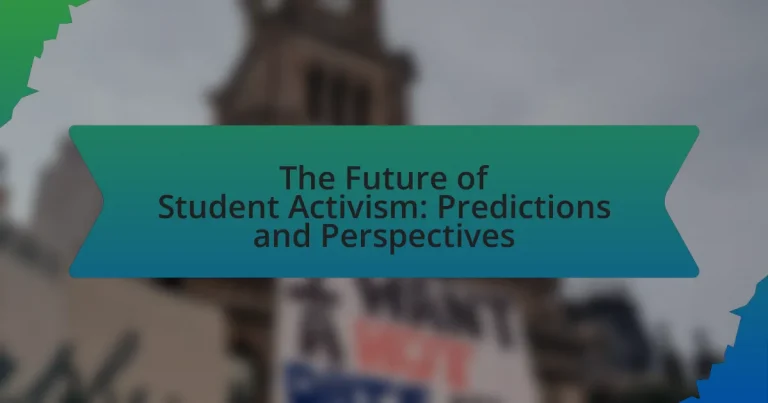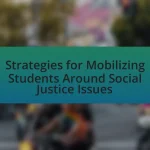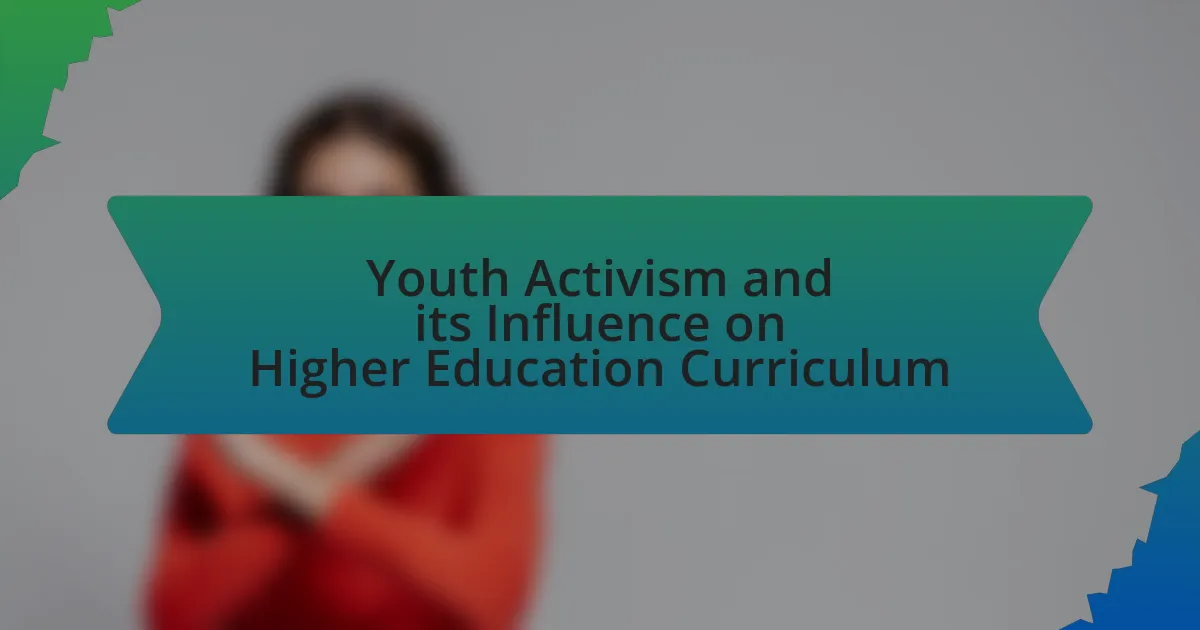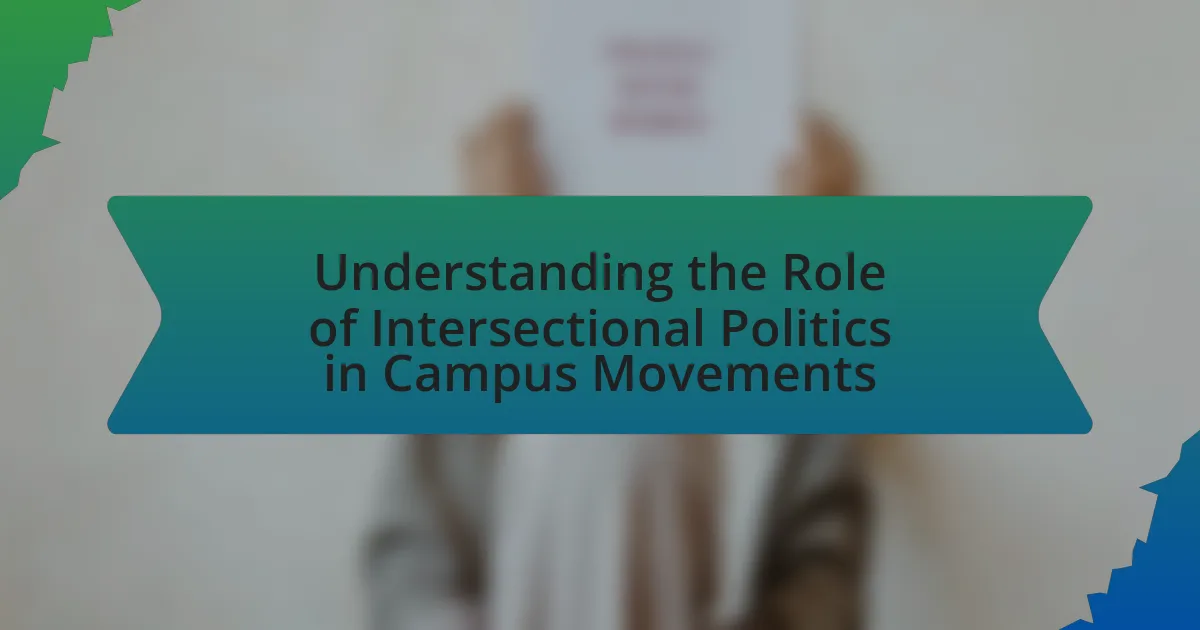The article examines the future of student activism, highlighting the anticipated rise of digital engagement and intersectionality as key characteristics. It traces the evolution of student activism from historical movements to contemporary digital platforms, emphasizing the influence of generational changes and key issues such as climate change, racial justice, and mental health. The article also discusses the impact of social justice movements, the role of technology, and potential challenges student activists may face, including governmental policies and backlash. Perspectives from various stakeholders, including educational institutions and policymakers, are explored, along with strategies for enhancing the effectiveness of student activism in future campaigns.
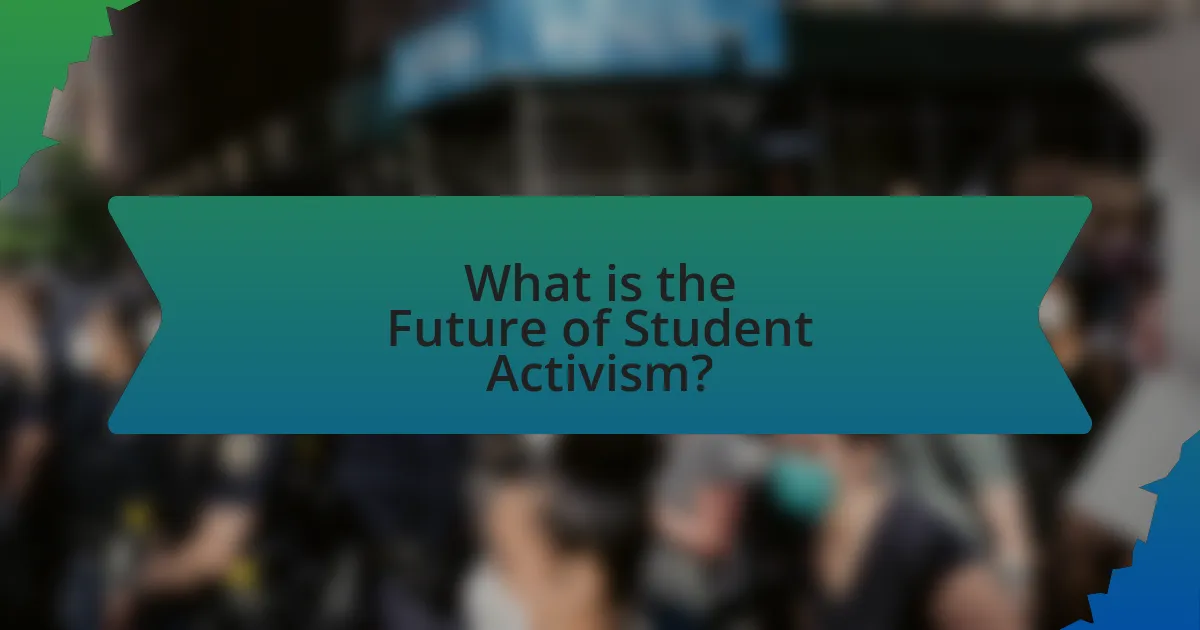
What is the Future of Student Activism?
The future of student activism is likely to be characterized by increased digital engagement and intersectionality. As technology continues to evolve, students will leverage social media platforms to organize, mobilize, and amplify their voices on issues such as climate change, racial justice, and mental health. For instance, the rise of movements like Fridays for Future demonstrates how students can effectively use online tools to advocate for systemic change. Additionally, the growing awareness of intersectionality will lead to more inclusive activism that addresses the interconnectedness of various social issues, as seen in the collaboration between different student-led organizations. This evolution reflects a shift towards a more global and interconnected approach to activism, where students are not only responding to local issues but also engaging with global challenges.
How has student activism evolved over the years?
Student activism has evolved significantly over the years, transitioning from traditional forms of protest to more digital and decentralized movements. Historically, student activism in the 1960s and 1970s focused on civil rights, anti-war protests, and campus issues, exemplified by events like the Kent State shootings in 1970, which galvanized student protests across the United States. In the 1980s and 1990s, activism expanded to include environmental issues and globalization concerns, with movements like Earth Day gaining traction.
In the 21st century, the rise of social media has transformed student activism, allowing for rapid organization and global reach, as seen in movements like #BlackLivesMatter and climate strikes led by figures like Greta Thunberg. This shift has enabled students to mobilize quickly and engage with a broader audience, demonstrating the power of digital platforms in contemporary activism. The evolution reflects changing societal issues and the adaptation of strategies to effectively address them.
What historical events have shaped current student activism?
Historical events that have shaped current student activism include the Civil Rights Movement of the 1960s, the Vietnam War protests, and the anti-apartheid movement in South Africa. The Civil Rights Movement mobilized students to advocate for racial equality and social justice, exemplified by the Student Nonviolent Coordinating Committee (SNCC) founded in 1960. The Vietnam War protests, particularly the Kent State shootings in 1970, galvanized student opposition to military involvement and highlighted the power of youth voices in political discourse. Additionally, the anti-apartheid movement saw significant student involvement globally, with campaigns on campuses advocating for divestment from South Africa, influencing contemporary activism focused on social justice and human rights. These events collectively established a legacy of student engagement in political and social issues, shaping the strategies and goals of current student activism.
How do generational changes influence student activism?
Generational changes significantly influence student activism by shaping the values, priorities, and methods of engagement among students. For instance, younger generations, such as Millennials and Gen Z, prioritize social justice issues like climate change, racial equality, and mental health, which drives them to mobilize and advocate for these causes more vigorously than previous generations. Research indicates that Gen Z is more likely to use digital platforms for activism, with 70% of them believing that social media is an effective tool for creating change, as highlighted in the 2021 report by the Pew Research Center. This shift towards digital activism reflects a broader trend where generational values evolve in response to societal challenges, leading to new forms of engagement and advocacy in student movements.
What are the key issues driving student activism today?
Key issues driving student activism today include climate change, racial and social justice, mental health awareness, and educational equity. Climate change has mobilized students globally, as evidenced by movements like Fridays for Future, which demand urgent action from governments. Racial and social justice issues have gained prominence, particularly following events such as the Black Lives Matter protests, prompting students to advocate for systemic change in their institutions. Mental health awareness has become critical, with students pushing for better resources and support systems on campuses. Lastly, educational equity remains a significant concern, as students fight against tuition hikes and advocate for accessible education for all. These issues reflect a broader societal context where young people are increasingly engaged in activism to address pressing challenges.
How do social justice movements impact student activism?
Social justice movements significantly enhance student activism by providing frameworks for collective action and raising awareness about systemic inequalities. These movements inspire students to engage in advocacy, often leading to organized protests, campaigns, and initiatives aimed at addressing issues such as racial injustice, gender equality, and climate change. For instance, the Black Lives Matter movement has mobilized students across various campuses to demand policy changes and promote inclusivity, demonstrating a direct correlation between social justice initiatives and increased student participation in activism.
What role does climate change play in student activism?
Climate change serves as a primary catalyst for student activism, driving young people to mobilize for environmental justice and policy reform. The urgency of climate-related issues, such as extreme weather events and rising sea levels, compels students to advocate for sustainable practices and governmental accountability. For instance, the global climate strikes initiated by students, inspired by activists like Greta Thunberg, have seen millions participate, highlighting the significant role of youth in demanding action against climate change. This activism is further supported by research indicating that younger generations prioritize climate action, with surveys showing that over 70% of students believe climate change is a critical issue requiring immediate attention.
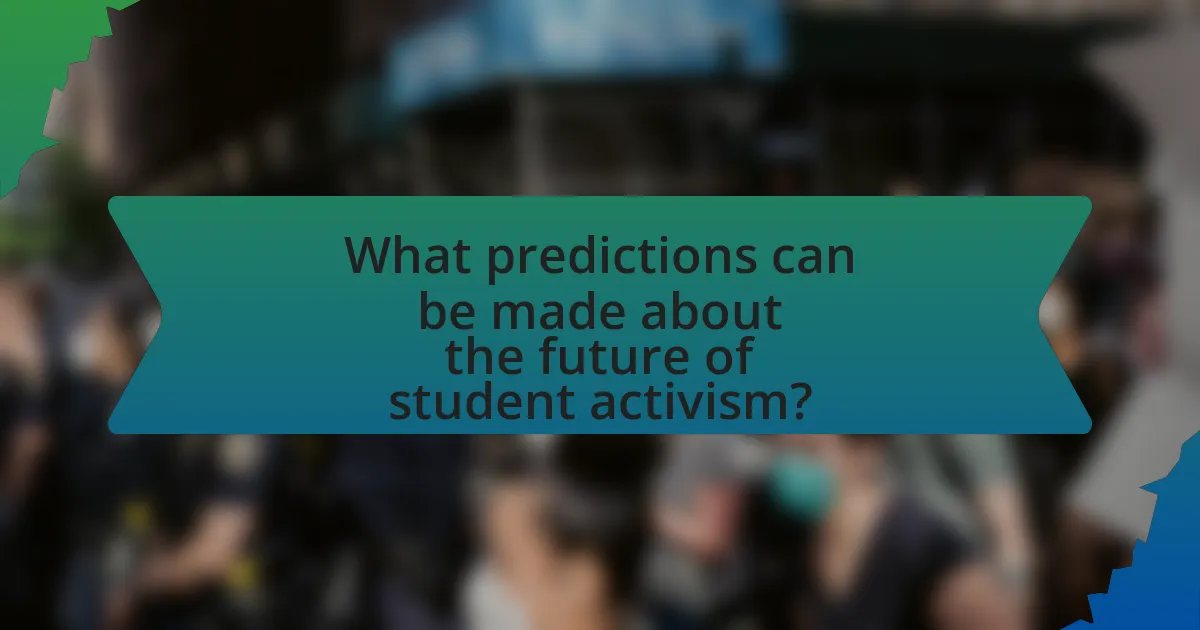
What predictions can be made about the future of student activism?
Future predictions about student activism indicate a rise in digital engagement and intersectionality. As technology continues to evolve, students are likely to leverage social media platforms for organizing and mobilizing, enhancing their reach and impact. Historical trends show that movements like Black Lives Matter and climate strikes have gained momentum through online platforms, suggesting that future activism will increasingly rely on digital tools for awareness and action. Additionally, the focus on intersectionality will likely grow, as students recognize the interconnectedness of various social issues, leading to more inclusive and diverse movements. This shift is supported by recent surveys indicating that younger generations prioritize social justice and equity, which will shape the strategies and goals of future student activism.
How will technology influence student activism in the future?
Technology will significantly enhance student activism in the future by providing platforms for organization, communication, and mobilization. Digital tools such as social media, messaging apps, and online petitions will enable students to quickly disseminate information, coordinate events, and rally support for causes. For instance, the use of social media platforms like Twitter and Instagram has already shown to amplify movements, as seen in the global response to climate change led by youth activists like Greta Thunberg, who utilized these platforms to mobilize millions. Furthermore, advancements in technology, such as virtual reality and augmented reality, may create immersive experiences that deepen engagement and awareness around social issues. Overall, the integration of technology into student activism will foster greater connectivity and efficiency, allowing for more impactful movements.
What digital platforms are emerging as tools for activism?
Emerging digital platforms for activism include TikTok, Instagram, and Discord. TikTok has gained popularity for its short-form video content, allowing activists to reach younger audiences quickly and creatively, as seen in movements like climate activism and social justice campaigns. Instagram serves as a visual storytelling platform where users share impactful images and narratives, facilitating awareness and mobilization around various causes. Discord, originally a gaming communication tool, has evolved into a space for organizing and community building among activists, enabling real-time discussions and collaboration. These platforms are increasingly utilized for grassroots movements, demonstrating their effectiveness in engaging and mobilizing supporters.
How can social media shape the narrative of student movements?
Social media can shape the narrative of student movements by providing a platform for rapid information dissemination and collective organization. This immediacy allows students to share their experiences, mobilize support, and amplify their voices on a global scale. For instance, during the 2011 Occupy Wall Street movement, social media played a crucial role in organizing protests and spreading awareness, demonstrating its power in shaping public perception and engagement. Additionally, studies show that social media can influence mainstream media coverage, as platforms like Twitter and Facebook often serve as sources for news outlets, further impacting the narrative surrounding student activism.
What potential challenges might student activists face in the future?
Student activists may face challenges such as increased surveillance and repression from authorities. As governments and institutions become more aware of activist movements, they may implement stricter measures to monitor and control protests, as evidenced by the rise in surveillance technologies used during demonstrations. Additionally, student activists might encounter difficulties in mobilizing support due to the fragmentation of social media platforms, which can dilute messages and hinder collective action. Historical trends show that movements often struggle to maintain momentum when communication channels are disrupted or manipulated. Furthermore, financial constraints may limit the ability of student organizations to sustain their activities, as funding sources become more competitive and restrictive. These challenges highlight the evolving landscape of activism and the need for adaptive strategies among student activists.
How could governmental policies affect student activism?
Governmental policies can significantly influence student activism by either facilitating or restricting students’ ability to organize and express their views. For instance, policies that protect freedom of speech and assembly encourage students to engage in activism, as seen in the U.S. First Amendment, which has historically supported student-led movements like the Civil Rights Movement and anti-war protests. Conversely, restrictive policies, such as those limiting protest locations or requiring permits, can hinder student activism by creating barriers to mobilization and expression. In countries with authoritarian regimes, such as North Korea, stringent laws against dissent effectively suppress student activism, demonstrating how governmental control can stifle youth engagement in social and political issues.
What are the risks of backlash against student movements?
Backlash against student movements can lead to increased repression, diminished public support, and potential violence. When authorities perceive student activism as a threat, they may respond with punitive measures such as arrests, censorship, or the implementation of restrictive policies, as seen in various global contexts like the 2019 Hong Kong protests. This repression can alienate the broader community, reducing sympathy for the movement and leading to a loss of allies. Furthermore, backlash can escalate tensions, resulting in violent confrontations, which can further delegitimize the movement in the eyes of the public and policymakers. Historical examples, such as the Kent State shootings in 1970, illustrate how backlash can have tragic consequences, reinforcing the risks associated with student activism.
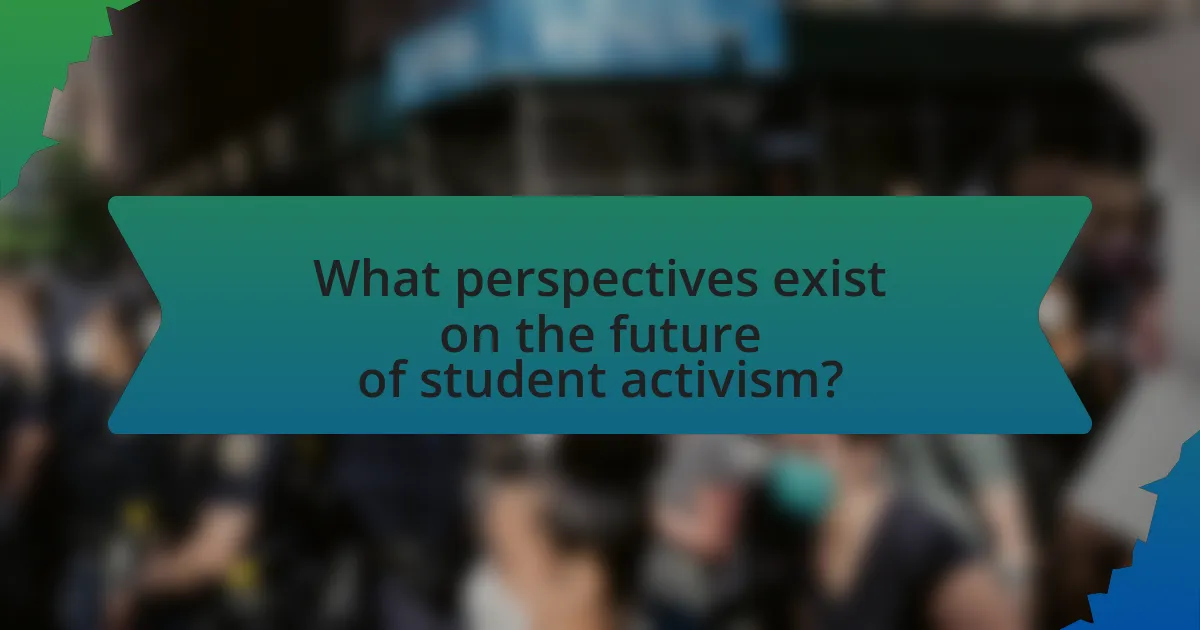
What perspectives exist on the future of student activism?
Perspectives on the future of student activism include increased digital engagement, intersectionality in social movements, and a focus on sustainability. Increased digital engagement is evident as students leverage social media platforms for organizing and advocacy, allowing for rapid dissemination of information and mobilization. Intersectionality is becoming a central theme, as activists recognize the interconnectedness of various social issues, leading to more inclusive movements that address multiple forms of oppression. Additionally, a focus on sustainability reflects a growing awareness among students about climate change and environmental justice, prompting activism that prioritizes ecological concerns alongside social issues. These perspectives indicate a dynamic evolution in student activism, shaped by technological advancements and a broader understanding of social justice.
How do different stakeholders view the future of student activism?
Different stakeholders view the future of student activism as increasingly influential and diverse. Educational institutions often see it as a vital component of civic engagement, encouraging students to participate in social issues and policy discussions. Policymakers recognize the potential of student activism to drive legislative change, as evidenced by movements like the March for Our Lives, which successfully advocated for gun control reforms. Corporations may view student activism as a reflection of consumer values, prompting them to adopt more socially responsible practices to align with the expectations of younger generations. Nonprofit organizations see student activism as a source of fresh energy and innovative ideas, essential for addressing contemporary social challenges. Overall, stakeholders acknowledge that the future of student activism will be shaped by technological advancements, social media influence, and a growing emphasis on intersectionality in social justice movements.
What are the perspectives of educational institutions on student activism?
Educational institutions generally view student activism as a vital expression of democratic engagement and social responsibility. Many universities recognize that student activism fosters critical thinking, leadership skills, and civic engagement, which are essential components of a well-rounded education. For instance, a study by the American Association of University Professors highlights that institutions often support student-led initiatives that promote social justice and community involvement, reflecting a commitment to academic freedom and the development of informed citizens. However, some educational institutions may also express concerns about the potential for activism to disrupt academic activities or create divisive environments on campus. Overall, the perspectives of educational institutions on student activism are multifaceted, balancing support for student voices with the need to maintain a conducive learning environment.
How do policymakers perceive the role of student activism?
Policymakers generally perceive student activism as a vital force for social change and a reflection of the concerns of younger generations. They recognize that student activism can influence public policy, as evidenced by movements such as the March for Our Lives, which successfully advocated for gun control reforms following school shootings. This perception is supported by studies indicating that student-led initiatives often mobilize significant public support and can lead to legislative changes, demonstrating the effectiveness of youth engagement in political discourse.
What strategies can enhance the effectiveness of student activism?
To enhance the effectiveness of student activism, students should employ strategies such as building coalitions, utilizing social media, and engaging in direct action. Building coalitions with diverse groups increases the reach and impact of activism, as seen in movements like the March for Our Lives, which united students, parents, and organizations to advocate for gun control. Utilizing social media platforms allows for rapid dissemination of information and mobilization of supporters, evidenced by the viral spread of the #MeToo movement, which galvanized global participation. Engaging in direct action, such as protests and sit-ins, can draw public attention and pressure decision-makers, as demonstrated by the successful climate strikes initiated by students worldwide. These strategies collectively strengthen the voice and influence of student activism in addressing social issues.
How can collaboration between student groups improve outcomes?
Collaboration between student groups can improve outcomes by fostering diverse perspectives and enhancing resource sharing. When students from different backgrounds and disciplines work together, they can combine their unique skills and knowledge, leading to more innovative solutions and effective advocacy strategies. Research indicates that collaborative learning environments increase engagement and retention rates; for instance, a study published in the Journal of Educational Psychology found that students who participated in collaborative projects scored higher on assessments compared to those who worked independently. This synergy not only amplifies the impact of their initiatives but also cultivates essential skills such as teamwork and communication, which are vital for future success.
What best practices should student activists adopt for future campaigns?
Student activists should adopt strategic planning, effective communication, and coalition-building as best practices for future campaigns. Strategic planning involves setting clear, achievable goals and timelines, which enhances focus and resource allocation. Effective communication ensures that messages resonate with diverse audiences, utilizing social media and traditional platforms to maximize outreach. Coalition-building fosters collaboration with other groups, amplifying impact and resources, as evidenced by the success of movements like March for Our Lives, which united students across various demographics to advocate for gun control. These practices enhance the effectiveness and sustainability of student-led initiatives.
What practical steps can students take to engage in activism effectively?
Students can engage in activism effectively by organizing and participating in awareness campaigns that address social issues. This involves identifying a cause, researching it thoroughly, and collaborating with peers to create informative materials and events. For instance, the 2018 March for Our Lives, organized by students advocating for gun control, demonstrated how mobilizing peers can lead to significant public attention and policy discussions. Additionally, leveraging social media platforms can amplify their message, as seen in the #MeToo movement, which gained traction through student-led initiatives. Engaging with local communities and policymakers further enhances the impact of their activism, as demonstrated by student-led environmental initiatives that have influenced local legislation.
